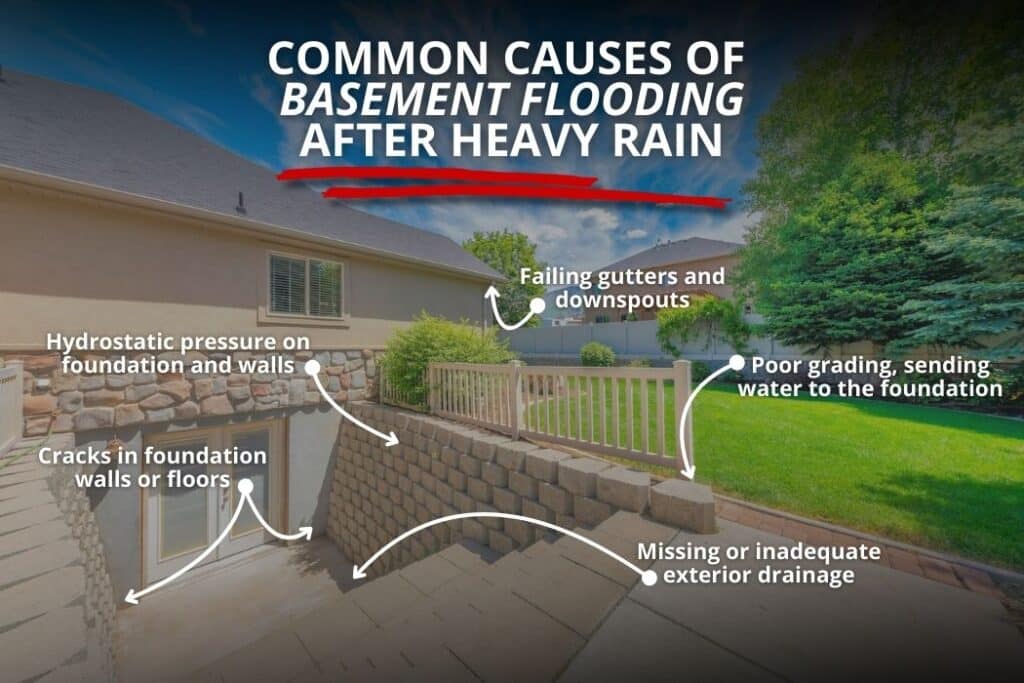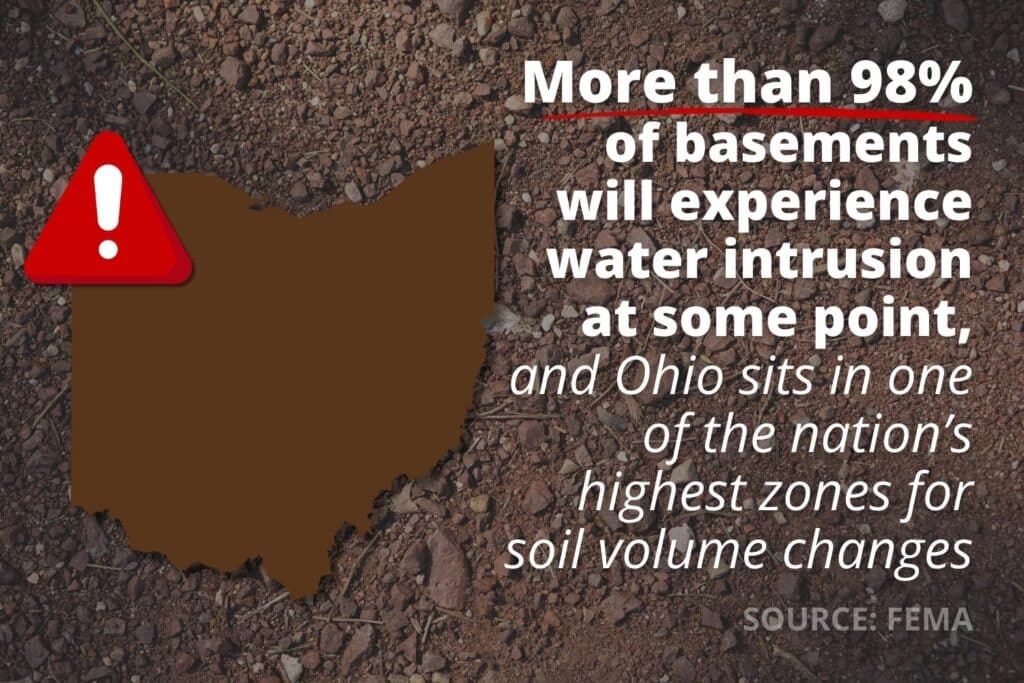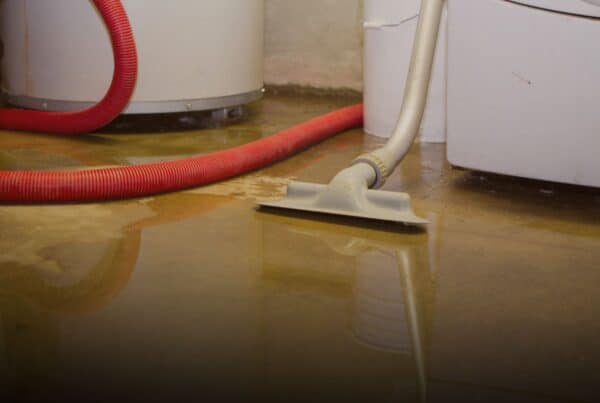This guide explains why water enters a basement after a storm, the conditions that make the Columbus region especially vulnerable, how to diagnose the source, and which fixes actually solve the problem.
Basements in the Columbus area take a beating during heavy rain. When the soil gets saturated, pressure builds around your foundation and forces water toward cracks, gaps, or weak points.
Many homeowners first notice small puddles, damp corners, or musty odors after a strong storm. Others find water seeping through walls or rising from the floor.
No matter how it appears, leak patterns during or after heavy rain almost always point to the same core issues. Water is finding a path into the basement because something around the foundation is allowing it in.
Why Does Heavy Rain Create Basement Leaks?
The short answer is that water leaks into a basement after heavy rain because saturated soil pushes moisture through cracks, weak spots, or drainage failures around the foundation.
Columbus has a mix of clay-heavy soil and fluctuating seasons. After long stretches of rain, the soil around a home expands with moisture. The added pressure forces water toward the lowest point it can reach, which is almost always the basement or crawl space.
FEMA reports that more than 98% of basements will experience water intrusion at some point, and Ohio sits in one of the nation’s highest zones for soil volume changes.
Several factors make this worse in Central Ohio:
- Clay soil retains water longer
- Short bursts of heavy rain overload drains
- Older homes lack modern waterproofing
- Snowmelt and rain often overlap in spring
- Gutters overfill easily in tree-heavy neighborhoods
When these conditions stack up, water often finds the easiest path into the basement structure.
The Most Common Sources of Leaks After Heavy Rain
Water intrusion nearly always comes from a predictable set of causes. Understanding these helps homeowners explain symptoms and avoid misdiagnosing the problem.

1. Hydrostatic Pressure Against the Foundation
Hydrostatic pressure is the number one reason basements leak after heavy rain.
As the ground becomes saturated, water builds pressure at the sides of the foundation. This pressure pushes moisture through even the smallest openings. Homeowners usually notice:
- A wet basement floor after storms
- Seepage lines on walls
- Water rising near the cold joint (where the floor meets the wall)
If this is happening, waterproofing and drainage improvements are needed. Buckeye Basement Solutions handles this issue regularly.
2. Cracks in Foundation Walls or Floors
Concrete naturally forms small cracks as the home settles. During storms, water takes advantage of them. Even hairline cracks can allow noticeable seepage. Structural cracks, which are larger or stair-stepped, can lead to larger leaks.
Ohio homes built on clay-rich soil see more cracking because of soil expansion and contraction.
3. Failing or Missing Exterior Drainage
If water cannot drain away from the home, it moves into the soil along the foundation.
Common signs include:
- Downspouts dumping water at the base of the home
- Gutters overflowing during storms
- Soft or sinking soil against the foundation
- Pooling water near exterior walls
A gutter system that is only partially clogged can still overflow during heavy rain, sending gallons of water directly into the soil beside your basement.
4. Weak or Incomplete Waterproofing
Older Columbus homes may not have modern waterproofing systems. Even newer homes may only have basic coatings that break down over time.
Interior waterproofing systems can also fail if the system is outdated or overloaded. This can cause leaks even when the exterior looks dry.
5. Sump Pump Problems
A sump pump protects the basement by removing water. When it cannot keep up during storms, water begins rising inside the home.
Leaks often happen when:
- The pump is undersized
- The pump is aging
- The pit is too shallow
- The discharge line is clogged or frozen
- The pump loses power
USGS data shows groundwater levels can spike quickly after intense storms, often overwhelming small or aging sump systems.
6. High Water Table Conditions
Some Columbus neighborhoods sit in low-lying areas. After long or repeated rainfall, the water table rises high enough to push water up through floor cracks or expansion joints.
This can look like water “coming up through the floor” even when the walls stay dry.
Buckeye’s team installs drainage systems and sump pump setups designed to manage high water table intrusion.
7. Window Wells and Wall Penetrations
Basement windows, vents, and utility penetrations can allow water in when the seals fail or when window wells clog during storms. This is a common reason for wet carpet or damp drywall after rain.
How to Diagnose Where the Water Is Coming From
Leak patterns can help reveal the source. Here is a simple breakdown:
- If the water appears at the base of the wall:
Likely hydrostatic pressure or exterior drainage issues. - If the water drips down the wall:
Likely small cracks, porous concrete, or weak waterproofing. - If water rises through floor cracks:
Likely high water table or sump pump trouble. - If the leak is near a window:
Likely a clogged or poorly draining window well. - If the leak appears on one side only:
Likely gutter or downspout failure in that area. - If the leak appears hours after the storm:
Likely slow soil saturation or underground drainage issues.
Suggested Solutions for Rain-Driven Basement Leaks
Buckeye offers several long-term solutions depending on the source and severity of the leak.
Interior Drainage Systems
These systems collect rising water and move it to a sump pump before it reaches the basement floor. They are one of the most reliable fixes for hydrostatic pressure.
Sump Pump and Pit Upgrades
Because Central Ohio often gets fast, heavy rain, many homes need updated sump systems.
Upgrades include:
- Higher-capacity pumps
- Battery backup systems
- Deeper sump pits
- New discharge lines with freeze protection
Foundation Crack Repair
Cracks are sealed using materials designed to move with the foundation. This helps prevent future water entry even as the soil shifts over time.
Waterproofing the Interior or Exterior
Exterior waterproofing places a protective barrier on the outside of the foundation.
Interior waterproofing blocks seepage from within.
Which one is best depends on the leak source and the age of the foundation.
Crawl Space Encapsulation
Homes with crawl spaces can experience moisture transfer between the crawl space and the basement. Encapsulation keeps moisture out and reduces humidity.
Clean Air Dehumidifier Systems
Moisture lingers long after a leak stops. The EPA recommends keeping indoor humidity between 30%-50%. A dehumidifier helps prevent mold and protect air quality.

Common Questions Homeowners Ask
Why does water rise through cracks in the floor?
This usually means the groundwater level is high after storms. Many homeowners look into sump pump performance and interior drainage systems.
Will cracks in the wall get worse over time?
Yes. Soil movement can widen cracks, especially in clay-heavy areas.
Why does my basement feel damp even without standing water?
Moisture can pass through concrete and raise humidity levels. This often leads homeowners to explore dehumidifiers or moisture barriers.
Can leaks lead to mold?
Yes. Mold can begin growing within one to two days in a damp basement.
When to Call a Professional
You should seek help when:
- Water enters the basement more than once
- The leak happens during most storms
- Cracks are growing
- The sump pump struggles to keep up
- The basement stays damp even on dry days
- There is a musty odor, staining, or visible mold
- You plan to finish the basement soon
These signs suggest deeper issues that require inspection and long-term solutions.
Conclusion
Water leaking into your basement after heavy rain is a sign that the soil around your home is pushing moisture through vulnerable points in the foundation.
With Ohio soil conditions, seasonal storms, and changing groundwater levels, this is a very common problem. The good news is that most leaks can be repaired permanently with the right combination of drainage improvements, sump pump upgrades, crack repair, and waterproofing.
Buckeye Basement Solutions helps homeowners across the Columbus region identify the true cause of basement leaks and create long-term fixes that keep basements dry.



